Digital Art History
The 1990's
Everything becomes digital.
1. Milieu and events
2. Arts and new artists
1. Milieu and events
See The digital context.
In 1993, the Xerox PARC artist-in-rsidence program is launched.
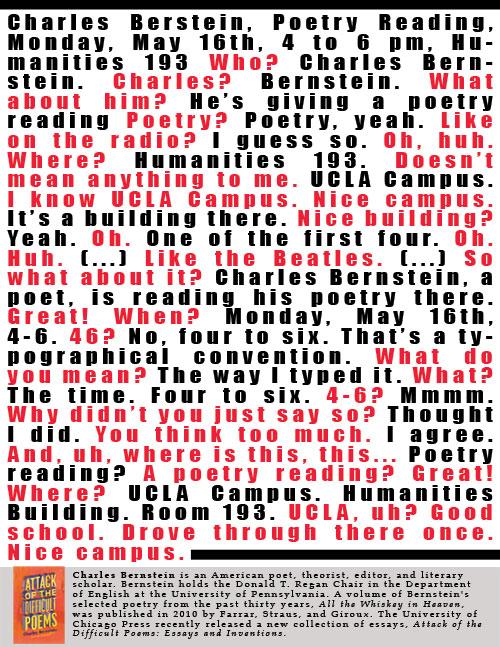
Brian Kim Stefans, animated text.
Digital art becomes more common, more merged into the "medias". The term "digital art" itself seems generally outmoded. In 1993 Popper preferts electronics ("L'art à l'âge électronique"). Some facts:
- 1990. Isea Inaternational (formerly Inter-Society for the Electronic Arts) is founded in the Netherlands. It's a nonprofit organization that aims to promote interdisciplinary academic discussion among culturally diverse groups and individuals who work in the areas of art, science and developing technologies.
- 1993. Xerox Parc initiates an artist-in-residence program.
- 1993. The Arts Catalyst (England) is launched, with a goal to commission contemporary art that experimentally and critically engages with science.
- 1994; "The World's First Collaborative Sentence", an ongoing project on the Web by artist Douglas David, is commissioned.
- 1996. Rhizome, a mailing list
-
1996. The Long Now Foundation.
- 1997. Creation of the ECM (établissements culturels multimédia) networks in France.
- 1997. Documenta X, "the biggest show on Eart" is directed by Catherina David in Kassel.
- 1997. Eyebeam Center for Art and Technology, in New York city.
- 1998. Digital art museum, international resource, founded by Wolfgang Lieser. Website divided into three sections, museum, gallery and award.
2. Arts and new artists
Literature
As a tool, the computer and its text processing ability push rapidly the typewriter in the museums reserves. But some writers go further in the new spaces offered by the now quite standard team: mouse and screen, printer, and of course the keyboard, particularly well adapted to this kind of art. Some attemps at voice recognititon will, at least in that time if not even 20 years later, remain of marginal use.
It inspires in particular several poets. Stefanie Strickland is quite a star in ELO. Some do simply poetry : Pedro Barbosa , Marc Battier , J.M. Lafaille, Alan Sondheim, or are scientifically oriented like Daniel Howe or Philadelpho Menezes. Vitrtual reality inspires Caterino Davinio and Ladislao Pablo Gyori. Luesebrink Marjorie_C. (aka M.D. Coverley) writes fiction and web fiction.
But some others explore the mysteries of generation : Rafael Perez-y-Perez, Brian Evans, orristophe Pechanatz (Pavlov generators) and Benoit Magné (combinatorial, presented at length by [Bootz]) or Antoine Denize. whose Typewriters is inspired by Queneau. and Perec.
Some technologies, typical of the period, give ideas: the floppy discs of Frédéric Develay, the CD-Rom of Jean-Michel Othoniel, connected to a website, the web itself for the cooperative works of Dragan Epsenschied and Alvar Freude, or the marvelous product, the Hypercard sofware John Cayley on Macintosh. He is not the only one to have lost data and creative activity when the product is dropped by Apple.
It's
a high time for hypertext: Lucie de Boutiny,
François Coulon (pretented at length in [Bootz]), Edward Falco, Carolyn Guyer (fiction), Robert Kendall poetry and multimedia, Deena Larsen, interactive hyperpoetry, Stuart Moulthrop, Jean-Maris Pelloquin, Martha Petry, Jean-François Verreault (a novel on the Web), Cédric Doutriaux, in search of expressivity.
Graphics are now comparatively easy to combine with texts, and many artists take the bait. For instance the collective work Scriptura et Caetera (1999), by Marie Belisle, André Savard and Michel Du_Bois, A set of poems and short texts which change according to geometrical shapes or Sale Temps (1997) by Frank Dufour, Gilles Armanetti, and Jacky Chiffot, a kind of photographic compositing. And also Komninos Zervos. Edouard Lussan goes up to interactive comic stips.
Last not the least, calligraphy and typography are applied by Antoine Bardou-Jacquet (abstract) Claude Faure (display on screen with typographic effects), Brian Kim Stefans (typographic animation), David Small .(Talmud project), Jevbratt /CS-Lisa (databases on screen).
Susan Berkenheger seems politically engaged. Kennetch Goldsmith is a theorist as well as a poet.Let's conclude with the complex, cooperative sort of memorial led by
Graham Harwood . (A lot in [Greene]).
< The Dickens Web, Storyspace Map (1992) by Paul Kahn, George Paul Landow, Julie Launhardt and Ronnie Peter. Disk, Eastgate Systems, Inc. See History of Computer Art, by Thomas Dreher.

Michael Jackson, digital structures deep into pop.
Music
About the "techno" music, see [Leloup, 2013].
We can distinguish three groups : software creators, algorithmic composers, music groups (more or less popular).
Software creators and scientists: Iain Bonardi, a scientist, Kemal Ebcioglu, creator of an expert system for music composition, Robert Henke also a composer, Hanspeter Kyburz, using L-Systems, Tod Machover. interactive writing and Olivier Sens., creator of Usine software. Let's quote also Xavier Rodet , sound scientist.
Algorithmic composers: Karlheinz Essl, Michael Gogins, Michael Jarrell and Emmanuel Nunes, a heir of Stockausen, interested in sound spatialization.
Groups and players:
Archive. Rock music group, may be working digital.
Chemical-brothers. Elecronica music.
Luca Francesconi. Composer, opera with electronic medias.
Ken Field . Jazz.
Peter Gabriel . The grand mixer.
Daniel Hosken. Composer, sound engineer, taking part in choreography
Michael Jackson. Uses savant music through his arrangers.
Bill Laswell. Jazz.
Trent Reznor. He likes technology.
Others
Ana Maria Avram
Craog Colorusso
Pete Braccio
Marco Cardini
Hugues Genevois
Kim Cascone. Complex research.
Aphex Twin More analog than digital... at least on the first works.
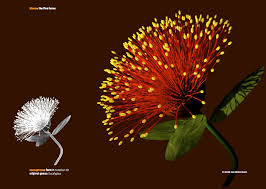
Jon McCormack
Graphics Painting, plastic arts
It's a great decade, especially for graphic arts. Powerful machines become affordable to artists (Silicon Graphics), with impressive software. The annual Siggraph session reach participation summits ((40 000). Great expectations are raised by virtual reality, mainly with head-sets (goggles) then with caves.
In short, we call:
-
"painting" images generated by hand or by algorithms, realistic or not,
- "photography" image generated by a camea, then more or less digitally transformed, combined, processed.
Some events :
- 1990 Batman: Digital Justice. The first all-digital comic book, is published by DC Comics
- 1995. Creation of The Algorists by Jean-Pierre Hébert, in California.
- 1996, Longavesne shows his big printers within the frame of spectacular performances.
Painting
Algorithmic painting :
- Generative works by Suzanne Anker, Pascal Dombis. 3D for Saridikhun Somasa, ASCII art with
Carsten Cumbrowski .
- Fractlists: Fractali, Steven Marc and Jean-Claude Meynard .
- Artificial live: Jon McCormack.
- Compositing: Pascal Monteil.
- Rendering of scientific data: Paul Harrison.
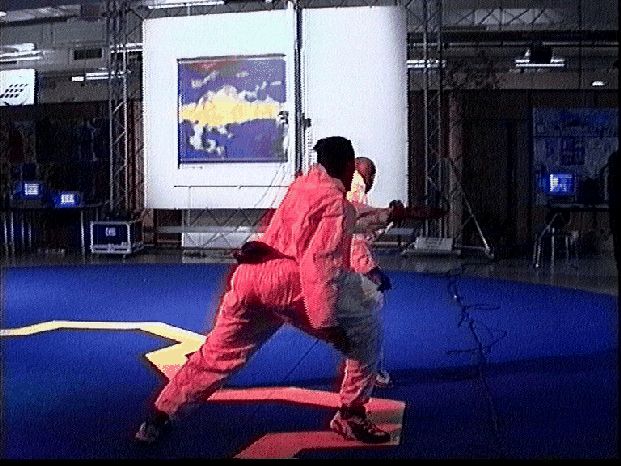
Jean-Paul Longavesne, performing.
Matte painting, figurative : Olga Tobrelutz, Wands (author of books presenting many artists), Oliver Wasow.
Other artists on this domain:
- Carl Banks. Programming.
-
Sophie Charrier (also a choreographer), James Faure-Walker (also a traditional painter, specially interested by colors ), Diane Fenster, Jochem Hendricks (black and white drawing), Wonhwa Hong,
- Martin Dörnbaum.
- Alain Longuet (coming from Video), Ken Musgrave, John Simon and Bogdan Soban.
- Multimedia orientation : Art+Com, Judith Darmont., Olga Kisseleva, Leonardo Sangiorgi (Studio Azurro group), Pal Thayer (installations) and Douglas Holleley (interaction using CD-Rom=.
- Use of special outputs : Jean-Paul Longavesne. (use or a very large printer, and sometimes performing in public using it), Ingo Gunther and RT Mark (images for the web). Dorothy Simpson-Krause (inkjet on metal).
- Spalter Anne,
- Leslie Thornton Kaleidoscope effets, not digital.
Photography
Several artists use the computer to transform the original photographs: Yoshiyuki Abe (stochastic processes), Scott Griesbach, Andreas Gursky,
KIDing (like commercials), Rauh Olaf ombines with architecture.
Catherine McIntyre (compositing).
Valérie Belin.
Some use special techniques: Peter Campus (high level scanning), Pedro Meyer, (considered the first photographer to use a CD-Rom), MaCynthia Rubin (scanning), Daniel Canogar (also a maker of animated sculptures) and Ilsn Sekula who takes pictures of financial moves.
Other photographers:
Philip Pocock,
Thomas Ruff, Mark Scheef, Michel Sémeniako, Lee Liz.
Cinema and animation
Cinema
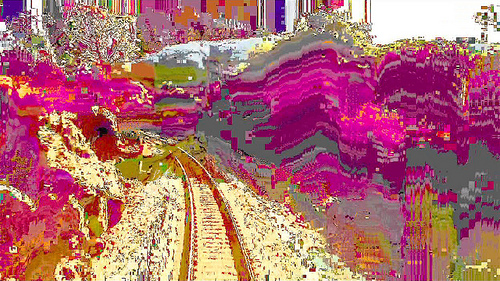
Jacqus Perconte: After the fire
It's perhaps a turning point: Peter Greenaway announces "the end of cinema". Out of the mainstream, we note diverse forms of researche and experimentation:
Amerika Mark. A poet and a VJ, now mostly on video
Sam Burkardt. TV emissions.
Robin Dupuis Video
Jim Gasperini. Interaction, game.
Agnes Hegedüs. Virtual reality. Reconfiguring the cave.
Jacques Perconte. Playing of the glich of video.
Charles Sandison . Video, immersion, interaction.
Eddo Stern. Film, limit to games.
Almiron Miguel Video
Arias Fredy Video
Koning Wobb_F Video
Rousseau Samuel Video
[Murray] p. 138 notes, about a CD-Rom exhibition in 1997 : "While some discussants lamented digitality as a marker of the death of cinema, a great many others lauded it for providing a catalyst for revival or forgotten cinemati histories, for the reinvention of cinematic form, and for sharpening of theoretical reasoning".
Animation
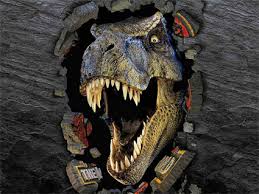
Jurassic Park
Two milestones : Jurassic Park (1993), by Amblin/Universal, with photo-real 3D digital dinosaurs by ILM and Toy Story (1995). Summits are reached which, perhaps have not been topped later, if not by the 3D relief masterpiece Avatar. And Ed Catmull, Pixar president, will say in 2010: "We believed that achieving the appearance of reality was a great technnical goal - not because we were trying to emulate reality, but because doing it is so hard it would drive us forward. That is, in fact, what happened. We finally reached the point where we can create convincingly realistic images. Reality was a great goal for a while. Now we have non-photo-realistic rendering goals and other things like that that have supplemented it".
Stars and mainstream:
Paul Debevec. High level animation techniques. A star.
Isaac Kerlow. Landscape. A star at Disney's.
Satoshi Kon . Japanese anime.
Hayao Miyazaki . Japanese anime
Andrew Stanton. Finding Nemo.
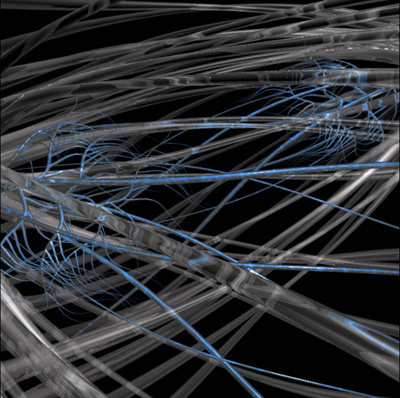
Alan Dorin
More research/avant-garde:
Mauizio Bolognini. Visual. Strongly generative.
Chu-Yin Chen. Highly symbolic.
Thom Demeyer. Software
Alan Dorin. Scientist.
Epizoo. Performance.
François Garnier. Exprimental cinema (animation). Digital techniques.
Larry Gritz. Developed tools at Cornell University.
Craig Kalpadjian. Digital synthetic video.
Thierry Kuntzel. Video, CD-Rom ?
Tina La-Porta. Webcam art.
Koichi Murakami. Behavioral art.
Frédéric Nagorny. Animation. Page Siggraph.
Maureen Nappi. 3D virtual painting.
Marte Newcombe. Forms evoking robots, maths.
Fabrizio Plessi. Video art, like Nam Jun Paik.
Karl Sims. Genetic art.
Douglas Stanley. Algorithmic, games.
Bill Viola. Mainly known as videon and fan collectors.
Koicihiro Yamagushi . Video and sculpture. A regular star in Siggraph.
Multimedia
It is difficult to classify more completely theses artists.
Annie Abrahams. Collective writing, performance, net art. ,
A.Strid . Mulimedia poetry, VJing.
Asymptote. Virtual environments.
Stéphan Barron. Multimedia and sociology.
Laura Bergman
Biederman Matthew . Transdisciplinary.
Simon Biggs. Immersive and interactive.
Jim Campbell. Photography and LEDs.
Adam Chodzko. A work about networks.
Luc Courchesne. Interaction, performance and video.
Carlos Cruz-Diez. About colors.
Minerva Cuevas. Installations, videos and photos
Peter D'Agostino. Immersive and interactive environment.
Linda Dement. New media.
Erwin Driessens and Maria Verstappen, 3D and robotics.
Jean Dubois. Installations/object, video. Interaction, fun.
Jean-Pierre Giovanelli. Synaesthesia.
Harvey Goldman. Animation, sculpture, paintings.
Bernard Gortais. Video installations reacting to meteo data.
Valéry Grancher. Mainly on ironical mode.
Ian Haig. Interacion, video, etc.
Evelybe Hebey
Kirsten Johannsen. Diverse, interaction, integrated video.
Wolf Ka. Audiovisual performance.
Knowbotic Research. Interdisciplinary, global communication.
Ulf Langheinrich. Multimedia. Works with Hentschlager.
Brenda Laurel. A theorist about relational art, politics, education.
Matthew Lewis. Painter and scientist. Line of websites.
Limiteazero. Architecture and design. Reflection about what is an interface.
Erik Loyer . Developer, complex works.
Gil Machac. Interactive video and transmedia architect.
Kaffe Matthews. Sonic bed. Immersive environment.
Feng Mengho. Games, interaction, global networking.
Christian Mignonneau and Christa Sommerer. Many different kinds of works.
Mongrel Group: Matsuko Yokokoji, Mervin Jarman, Richard Pierre-Davis and Graham Harwood
Paul Myoda. Light, sculpture...
CartstenNicolai. Sounds and multimedia installations.
Fred Nouveau
Mayumi Okura.
Mark Palmer. Virtual reality, immersive.
Jean-Marc Philippe. Keo project, space.
Philippe Piacenza. Multimedia director.
Michael Pontecorvo. Emergent design.
Glberto Prado . Multiscreen environments.
Troika Ranch. A vast mural multimedia...
Nicolas Reeves. A lot of sensors. Meteo.
Marc Roques
Saint-Clair "Whatever media"
Gehrard Sengmüller. Videovinyl project.
Jill Scott. Interactive, video, CD Rom.
Nina Sobell. Collaborative creation wih brain waves.
Yoshihide Sodeoka
Gerald Von-der-Kaap. Photograhy...
Pascale Weber
Jane Zweig
Joseph Lefevre
Rachel_Viadel Knowlsl
Design, sculpture, architecture
Light
Not a great decade (quantitatively) for this specialty,
Laurent Bolognini . Bulbs or LEd's on moving (rotating) beams.Nicola Evangelisti . Neon tubes.
Daniel Canogar. Moving objects, photography...
Yann Toma . Works on Ouest-Lumière archives.
Robotics
Ken Goldberg
Lynn Hershman
Oriza Hirata
Yves-Amu Klein
Bill Vorn
Zwanikken Christiaan
Sculpture
Eva Aeppli
Keith Brown
Tullio Brunone
Denis Pondruel
Daniel Rozin. The man with mirrors.
Derrick Woodham
Design, objects
Maywa Denki
Jonathan Ive
Linda Lauro-Lazin
Shin'Ichi Takemura
Kinetic art
Fonséranes
Helen Golden
GreatHouse Labs
Otto Piene
Peter Keene
Tim Lewis
Architecture
Manuel Abendroth
Peter Cook
Jérôme Decock
Foster +Partners
Stephen Hobbs. An article with images in [Dermineur]
Pierre Huyghe
Jakob+MacFarlane
Rem Koolhaas
Greg Lynn
Marcos Novak. Virtual architecture.
Nox/Lars Spuybroeck
Jean-Philippe Poirée-Ville
Thierry Prieur
Celestino Soddu
Nader Tehrani
Els Vermang
Saguez Olivier
Performance
Carlos Barcena . Opera with digital 3D effects.
Clyde Chabot. Communauté inavouable, experimental theater.
Isabel Chang. Does not communicate out of Linkedin.
Rae Davis. Performance and installations CD-Rom.
Lackaal Duckrick. More humor than technology.
Ken Field . Music, jazz.
Marina Grzinic
Hashiya Kazuhiko
Arthur Kopit's. Theater + added virtual spacde.
Robert LepageX
Outrapo
Mark Reaney
Helder Vasconcelos
Robert Wilson
Baumann Alain Theater
Dance
Mark Coniglio. A founder of Troika Ranch with Dawn Stopiello . Algorithmic choreograhy.
Corsino N+N
Ruth Gibson and Bruno Martelli form the Igloo group. From dance to installations.
Catherine Langlade. Spideka group. "The interpreter does not drives the image, but synchronizes himself with her" ([Aziosmanoff]).
Frank II Louise. Uses the computer to compose, and sensors on the dancers.
Benoit Maubrey . Sensors on dancers.
Rachid Ouramdane
Kirk Woolford . Installations, motion sensing
Helena Zwiauer . Founded Palindrome with
Interaction
Rébecca Allen. Interactive biological video.
Susan Akraut . with Michael Girard. Stereoscopic binoculars to enter a virtual world populated with animals.
Larry Bell. Sort of installations.
Diane Bertolo. Interaction, dataglove, net art.
Serge Bilous. CD Rom. Interactive writing.
David Blair. . Database cinema.
Angela Bulloch. Bio feedback and multimedia.
Mario Canali. Interaction, painting. An iPad app.
Ivan Chabaneau Virtual
Susan Collins. Interaction, sound, etc.
Fabio Crifino. A member of Studio Azurro. , Paolo Rosa (visual arts and film) and Leonardo Sangiorgi (graphic arts and animation). In 1995 Stefano Roveda
interactive systems expert, joins the group..
Carlos Cruz-Diez . Experiences in color.
Nina Czegledy. Multi-sensoriality.
Jean-Marie Dallet. Sliders Lab group.
Char Davies
Paul Devautour
Ivor Diosi. A sort of anti-artist.
Diana Dominguez
Toni Dove
Ken Feingold
Frank Fietzek
Masaki Fujihata
Paul Garrin
Michael Girard
Perry Hoberman
Carsten Höller
Pamela Jennings
Richard Kriesche
Fabien Lagny
Bernie Lubell
Michael Naimark
Outrapo
Simon Penny
Kurt Ralske
Thecla Schiphorst
Joel Slayton
Graham Smith . Interaction, photos.
Bill Spinhoven
Studio Azurro
Alexander Tuchacek
Jeff Wall
Chiara Passa . Video and installations.
Games
Natalie Bookchin
Christina Casanova
Brody Crondon
Robert Nideffer
Tandavanith Nick
Adams Matt
Farr Ju_Row
Tools
Paul Brown
Tina Chow
Hugo De_Garis
Derrick de_Kerckhove
Herbert Franke
I-maginer
Thomas KaulmannX
Craig Reynolds
Tatsuo Unemi
Walter Van_der Cruijsen
Eric Wenger
Web
1995. The phrase net.art coined by Vuk Cosic.
1993. Jean-Pierre Giovanelli : Installations SOS Tiers Monde (1993) and IO (1996).
Yae Akaiwa
Akshun
Arvids Alksnis
Barbara Aselmeier
Rachel Baker
Virginia Barratt
Ben Benjamin
Joachim Blank
Luther Blissett
Heath Bunting
Paul Demarinis
Ricardo Dominguez
Judith Donath
Reynald Drouhin
Ez3kiel
Luca Frelih
Nicolas Frespech
Matthew Fuller
Olivier Goulet
Colin Green
Eva Grubinger
Amin Haase
Peter Halley
Hugo Heyrman. Telesynaesthesia.
G.-H. Hovagymyan
Felix-Stephan Huber
Christian Huebler . Relational and net art.
Kathy Rae Huffman
Jon Ippolito
Adriene Jenik
Karl Heinz Jeron
Jodi-Group
Yael Kanarek
Carmin Karazic
Takuji Kogo
Vitali Komar
Jan-Robert Leegte
Barbara London
Alexander Melamid
John Mount
Prema Murthy
Mark Napier
ParkBench
Marko Peljhan. Web.
Juliane Pierce
Simon Pope
Francesca Rimini
Michail Samyn
Jason Schleifer
Kass Schmitt
Vivian Selbo
Kensuke Sembo
Paul Sermon
Alexek Shulgin
Cornelia Sollfrank
Teo Spiller
Brett Stalbaum
Josephine Starrs
Stahl Stenslie.Net, relational, cyber SM.
Gerfried Stocker. Robots, net, interaction
Igor Strohmajer
Suzanne Treister. Web, identity
Akke Wagenaar
Yvonne Wilhelm
Maciej Wisniewski
Eva Wohlgemuth
Stefan Wray S
Bio-Art and artificial life
Louis Bec. Partly derisive. Not properly digital;
Sam Brixey.
Ursula Damm
Verena Friedrich
Jean-Claude Heudin. Scientist about AL
Marion Laval-Jeantet
Eduardo Kac
Kevin Kelly
Berndt Lintermann. Visualization of complex shapes, AL.
Benoït Mangin
DICCAN'S PARTNERS:
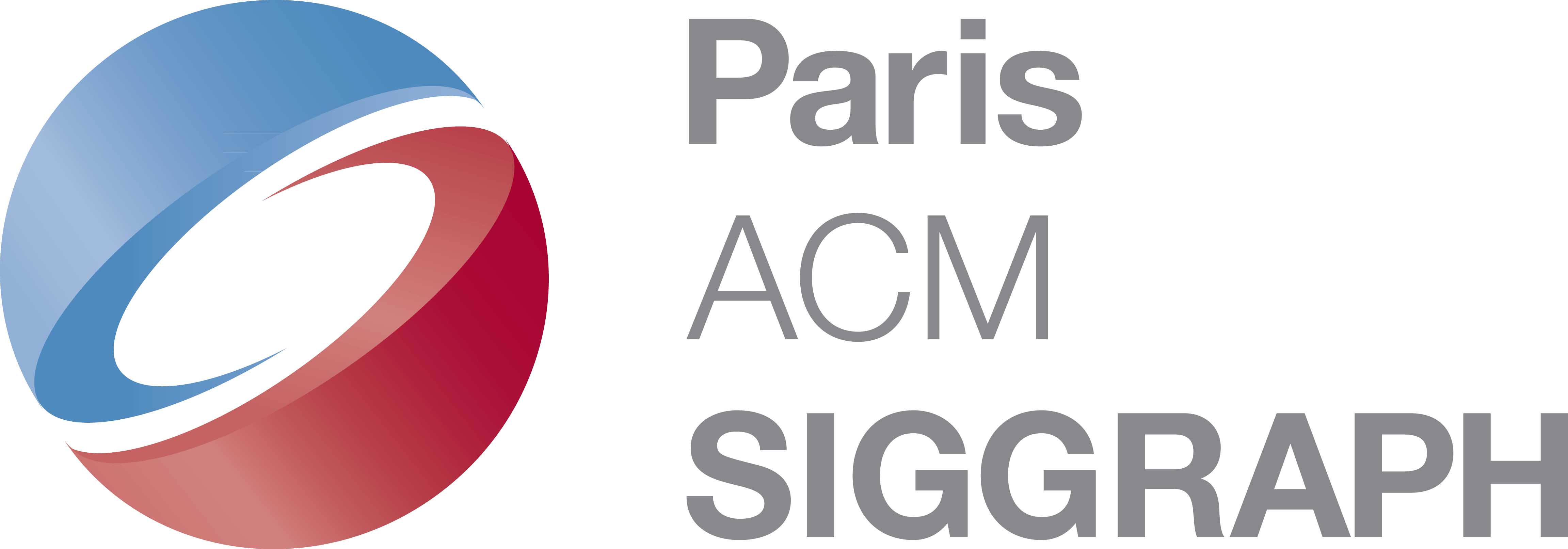
Paris ACM Siggraph, the French chapter of ACM Siggraph, worldwide non-profit organization of computer graphics.
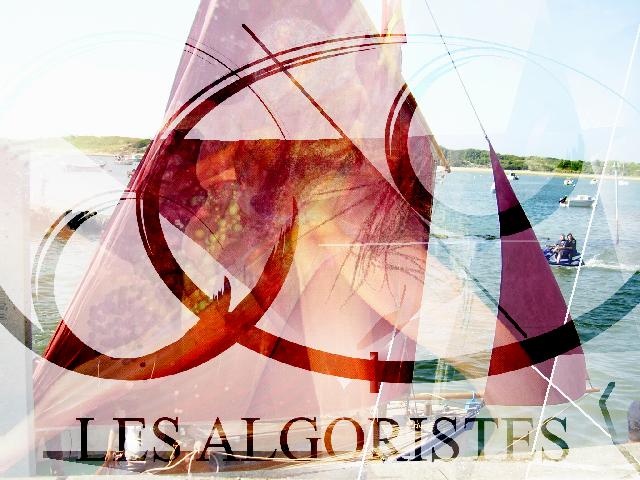
Les Algoristes, an association of artists using their own algorithms in their work.
